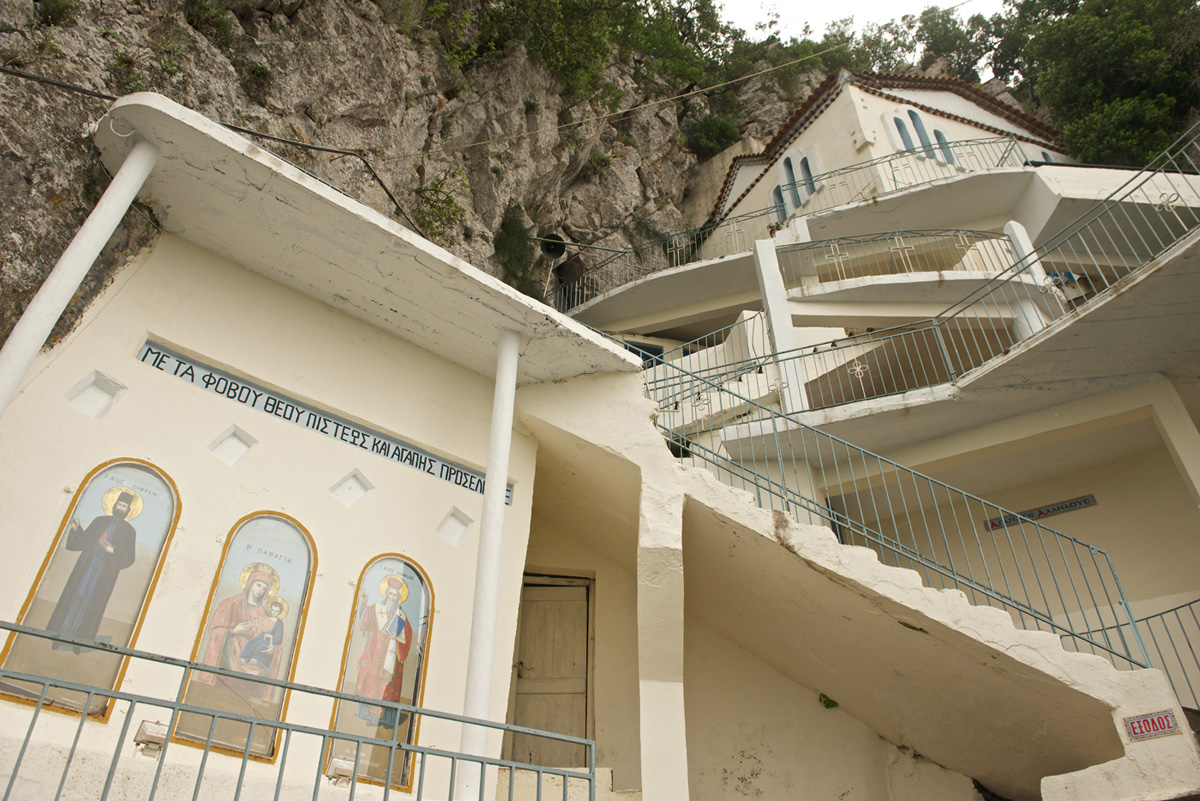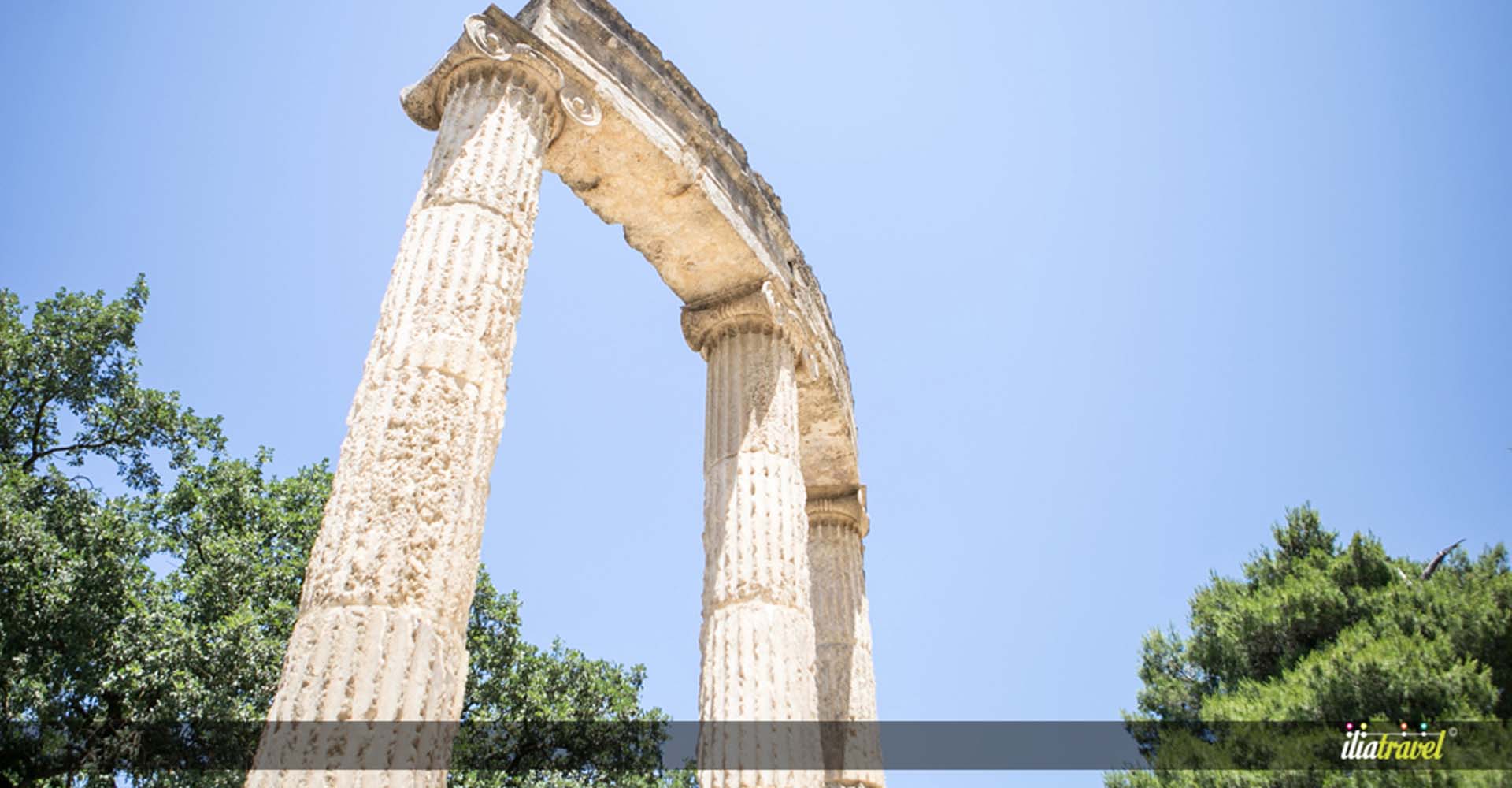1. Holy Monastery of Asketi Goumerou
Holy Monastery of Asketi Goumerou
In a green canyon that has been declared a Natural Monument, is located the Holy Monastery of Asketi Goumerou, a cave monastery, hidden in the depths of the centuries. It is one of the most magnificent monuments of the prefecture of Ilia, with Byzantine probably origin and exceptional beauty, which the visitor will not encounter anywhere else. According to oral traditions, the Monastery was created after the discovery of the icon of the Virgin Mary held by an infant from the inhabitants of the area of Goumeros and Olenas, who hunted up to that point a hermit, who is said to have been there, thinking that it is wild boar.
At the point where the two mountains blended and the cave of two caves was built, the monastery, which for many years was a monastic center. Indeed, once the Monastery housed more than fifty monks, it was abandoned in the last half century. Other historical references indicate that this area was probably a former ancient sanctuary, the cobbled paths existed long before the monastery and that the area was closely linked to the area and the ancient olives that exist in the surrounding area as well as to the mountainous route followed by the athletes in order to get from Ancient Elida to Ancient Olympia in order to participate in the Olympic Games.
Monastery of Panayia Kremasti in Lanthi
Monastery of Panayia Kremasti in Lanthi stands impressive and impresses with its volume as if hanging on the rock. It is found in the local community of Lanthi in the municipality of Pyrgos and is said to have been discovered when, 800 years ago, residents of the area saw a light in the evening in a hole in the rock. So someone was hung with a rope, who found the image of the Virgin Mary suspended. The monastery celebrates on August 23rd. Thousands of pilgrims during the evening pray and on the feast day are flocking to worship the Lord. The monastery receives thousands of pilgrims throughout the year. From the church’s balcony, the visitor will see all the beauty of the land of Ilia up to the forest of Foloi and the majesty of Erymanthos. Visitors can go to the monastery from the village of Lanthi or from Lambeti at 8 km. In both cases the scenery is beautiful. Today the monastery consists of 17 Nuns.
Monastery of Skafidia
The Monastery of Skafidia is located just 10 kilometers from Pyrgos and next to the blue waters of the Ionian Sea, at the mouth of the river Iardanos. The visitor will be stunned by the medieval fortress that surrounds it. The monastery of Panagia Skafidiotissa, from which it took its name, was built in the 10th century AD. In addition to its remarkable architecture, it has many treasures, such as sacred utensils, vestments, relics, uniforms, weapons, icons, coins, votive offerings and the banner of the Monastery, from a hand-painted icon with dedication to the Virgin Mary. Important is the Monastery’s archive and the library with many manuscripts, which refer to functional, musical, hagiographic and other themes, but also to the history of the monastery and its participation in the Greek Revolution of 1821.
Catholic Virgin
It is a Byzantine church and belongs to the type of double-crossed inscribed temple. It dates back to the 12th century, it has a semi-hexagonal arch, a dome with a eight-sided drum and a narthex in the west. Unique Frankish influence 9 (14th century) the long-arched arch of today’s northern door. The later addition of an exonarthex and the newer larger door openings constitute the only major interventions in its original form. Two layers of frescoes are preserved inside. The second, according to an inscription dated 1702, was made at the expense of Bishop Olenis Ioannikios. A second inscription of the same era, which mentions the builders of the temple and the year of erection in 1279, probably duplicates the oldest inscription. Everyone in the wider region believes that the Byzantine church of Panagia Katholikos has many secrets to the existence of Gastouni in history. That is why excavations that have taken place from time to time, where important findings have been found, are of particular importance
Monastery of Panagia Eleousis
The monastery of Panagia Eleousis is located near the village of Lygia in a deep green canyon, while next to it, one can admire the magnificent cave with its stalactites, which is considered water holy water. The monastery was built in the 9th century AD. and took its name from the icon of the Virgin Mary found and given her the name Eleousa, asking for the protection of the inhabitants of the area. Even during the difficult years of the Ottoman domination, the Monastery of Aghios Eleousas was a refuge for refugees, however, over the years from the successive destruction and looting, only the church and a half-destroyed tower, which probably served to protect the monks who were there by the raiders. This tower has now been repaired. Also the Monastery of Agia Eleousa played an important role in the revolution of 1821.
Holy Monastery of Sepetus
Sculptured on a rock, above the bank of the Triton River, the tributary of Alfios and a few meters from the ancient city of Alifeira, is located the Holy Monastery of Our Lady of Sepetus built from the 11th century AD. The interpretations for the name of the Monastery vary . According to a version, Sepetto comes from the phrase “on a fly”, which a faithful woman said as she cast her child, tied to the Virgin Mary, from the window of the Church, which was saved. Another interpretation of the phrase “Sepetos” connects it with the Slavic SOPOT, which means waterfall, since the river Triton flows with its famous cascade at the foot of the monastery.
The monastery was founded, according to historical sources, in 1150 AD. and played an important role during the period of Byzantium and the Frankish rule. In the marvelous Sepetos the grace of Panagia is famous all over Greece and is a religious destination for too many people. Sepetos Monastery is today a famous medieval monument and at the same time a sacred pilgrimage of thousands of Christians who resort to the miraculous power of the icon of the Virgin of Sepettiotissa.
Holy Monastery of St. Nicholas Fragapidimatos
The Holy Monastery of St. Nicholas Fragapidimatos was founded in the 14th century and is located 280m above the sea, 12km north of Pyrgos, at the homonymous hills, near Vounargos. Now the pilgrim is easily driven to the Monastery by a bypass, asphalt road, which bypasses the National Road of Pyrgos – Patras in the place of Kertizeika. In the tradition, a Franco persecuted by the Turks jumped with his horse from the rock to the void, inviting St. Nicholas, without anything, donating to it many lands.The Monastery is for females with 16 nuns. It was renovated after the earthquakes of 1993 and has a new, majestic and spacious Byzantine temple temple. The older sisters were engaged in hand-woven textiles, which were awarded at the Thessaloniki Exhibition.
St. Sophia
In the “heart” of the local community of Andravida, in the municipality of Andravida – Killini dominate the ruins of Hagia Sophia. It is the only Gothic temple that survives in this situation throughout Ilia and not only, and according to history, the tabernacles of the medieval knights and the kings of the region were made of it. The church, according to reports, was built in the 13th century by Dominican Catholic monks who had settled in the new state. From this Temple, with a length of more than 45 meters, today only the sanctuary is preserved. St. Sophia was constructed in accordance with the rules of Gothic architecture, with pointed arrows in the domes and openings. The building was made of porous stone but the builders added to the masonry pieces from older buildings – ancient or Byzantine. Strong vertical walls supported this large building externally, while in the magnificent interior the roof crossings drew the look of the faithful.
Isovas Monastery
According to historical references, the Isovas Monastery was built in 1223-1225 by Cistercian monks of Clairvo. The monastery consisted of its elongated Katholikon, its embedded vertical abbey building, C-shaped as well as two opposite walls, extending the sides so that the outline of the monastery is a quadrilateral. In the rest of the northern side of the Katholikon, on the west side of the Abbey and on the inner side of the walls, there was a continuous wooden shed, resting on wooden columns, creating a peristyle leaving a patio inside. The building has several characteristics of the Gothic temples. It is a single-aisled basilica covered with a rocky roof according to the temples of the Western temples in the 12th and 13th centuries.
The ruins of the Monastery – one of the most important Gothic monuments in Greece – are located west of the village of Tripiti in the municipality of Andritsena – Kresten, in a small valley. The remnants of the impressive building stand behind the church of St. Nicholas, which was later created. The length of the monastery exceeds 40 meters and the northern wall and the western arch have been preserved from there. Its characteristic feature was the slick windows. Also to the north of the temple are traces of the monks’ cells.
10. St. Nicholas
St. Nicholas
St. Nicholas church. is located in the central square of the town of Pyrgos, bearing the name “Sakis Karagiorgas”. It is the Metropolis of Pyrgos and its architectural style is a three-aisled basilica. In 1885 it was destroyed by the earthquakes, with the first works from its reconstruction to take place in May 1889. In fact, for the reconstruction of the Holy Church of St. Nicholas at that time, special craftsmen of marble and stone from the Sporades arrived at Pyrgos. In 1904 the municipality of Pyrgos decided to donate four thousand drachmas for the completion of the Temple, which was inaugurated in 1906. The Metropolitan Church brings into its interior important portable icons, most of which are donations of citizens and associations. A special mention is worth donating from the former MP Nakis Avgerinos of the image of the Crucifixion of Christ, which is a faithful copy of the painting of Dominique Theotokopoulos (El Greco) which the donor brought from the Prado Museum of Spain where the original work is. In front of the Metropolitan Church, there are the busts of Metropolitan Oleni, Philaretos, who was tortured and hanged in Tripoli in 1821 and the late Metropolitan of Ilia, Athanasios. The Temple reopened in 2014 in order to carry out major renovations and maintenance work, reopening its gates to the believers in December 2017.






